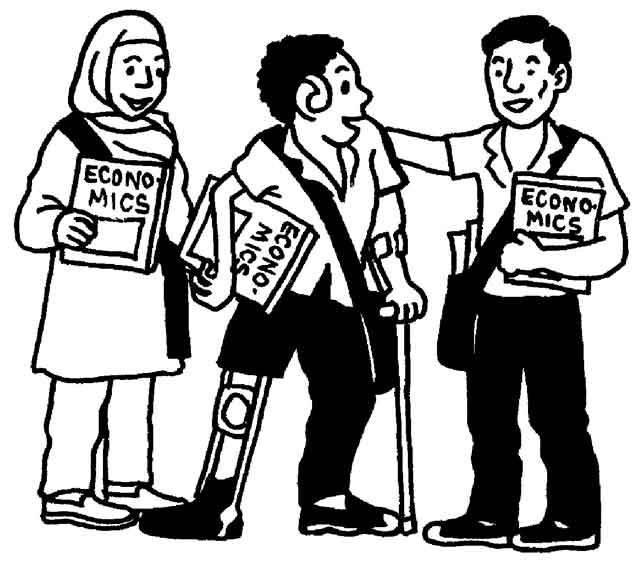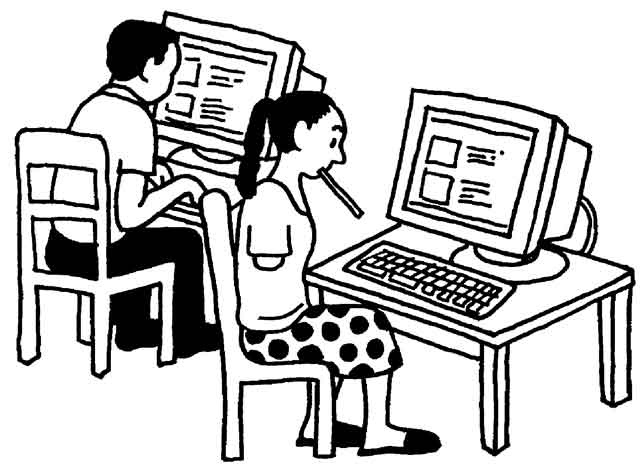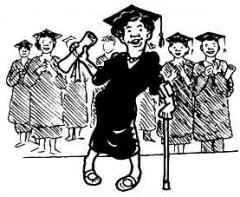Your progress
0%
The activities below can help you support youth and adults with disabilities in accessing secondary and higher education:

Use your mouse or keyboard to expand each of the activity headings below. To add an activity to your action plan, select the Add button beside it. Once you have added an activity to your action plan, select Action plan > My action plan from the menu above to complete that activity.

Often secondary and higher education facilities are located away from the student’s community. This can make involving the community more challenging. However, there are several things that CBR can do to facilitate community involvement:
Learn about how a community in Nepal used the funds that they raised.


In Ukraine, parents are very involved in an inclusive secondary school for 1000 students. Their activities include:
Some families may be quite resistant to the idea of students with disabilities having access to secondary or higher education. There can be many doubts, difficulties and adjustments that create obstacles to full support for students with disabilities from their families. CBR personnel can educate and support families so that they offer support to students with disabilities, both during their education and in transitional periods.
Learn about how parents in a community Ukraine actively participated in making the secondary school inclusive.


In Ukraine, parents are very involved in an inclusive secondary school for 1000 students. Their activities include:
The Special Education Council provides funds for five staff in the field. A private funding group and non-governmental organizations sponsor the students with disabilities.

While many of the activities in the secondary and higher education element are similar to those in the Primary education element, there are some specific things to consider when supporting secondary and higher education, such as environment and location, curriculum and teaching methods, examination and assessment, information and communications technology and peer support and role-models.
CBR can encourage schools and colleges to use specialist resources to increase the inclusion of students with disabilities.
In addition to encouraging the best use of these resources, it is also important to consider carefully the use of special schools.
Learn about how a school in Nepal helps students with disabilities prepare for inclusion and transition into regular classes.


Cherry was born with clubfoot deformities into a very poor farmer’s family in the Philippines. With the help of a local philanthropist and CBR she underwent surgery and received customized footwear. When she went to Secondary school, she was teased and excluded from participating in activities with the other students. However, with the help of her family, CBR personnel and her own determination, Cherry continued her studies despite the discrimination.
In high school, she was treated better, and a local non-governmental organization – Simon of Cyrene – supported her higher education costs, including transportation, school supplies and even medical and health services. Following high school, she was given a scholarship to complete a two-year college course on computer applications. Like her peers, Cherry is now working on the open job market.
Cherry says: “Now I am very proud of reaping the fruits of my labour. I am helping my family financially and I can provide for my personal necessities. The people in our community who used to stare and laugh at me have changed their perception of me. Now I can see admiration in their eyes that even with disability I was able to attain the status where I am in now. My self-esteem and confidence have been enhanced, enough to give me strength to face the challenges that may come along.
This is a key issue and often overlooked. Transitional periods during education include:
Often, students with disabilities are required to move away from their communities to complete higher education. This move can make transitional periods more difficult, and many find it very challenging to adjust without the support of their families and communities.
Research highlights the fact that, because of poor transitions, twice as many students with disabilities fail to pursue college as their peers.
CBR can work with students, families, community members and educational institutions to ensure supportive links are created and maintained throughout transitional periods. The Rwanda case-study cited at the beginning of this element illustrates how collaboration and lobbying helped achieve successful transitions.
Learn about how a young woman with clubfoot overcame the challenges she faced in education with the support of CBR that helped her through her transitions.


Cherry was born with clubfoot deformities into a very poor farmer’s family in the Philippines. With the help of a local philanthropist and CBR she underwent surgery and received customized footwear. When she went to Secondary school, she was teased and excluded from participating in activities with the other students. However, with the help of her family, CBR personnel and her own determination, Cherry continued her studies despite the discrimination.
In high school, she was treated better, and a local non-governmental organization – Simon of Cyrene – supported her higher education costs, including transportation, school supplies and even medical and health services. Following high school, she was given a scholarship to complete a two-year college course on computer applications. Like her peers, Cherry is now working on the open job market.
Cherry says: “Now I am very proud of reaping the fruits of my labour. I am helping my family financially and I can provide for my personal necessities. The people in our community who used to stare and laugh at me have changed their perception of me. Now I can see admiration in their eyes that even with disability I was able to attain the status where I am in now. My self-esteem and confidence have been enhanced, enough to give me strength to face the challenges that may come along.